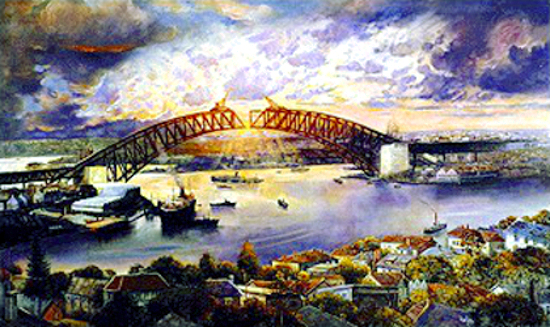Project Description
1928-1948
This painting portrays the beautiful arch of the Sydney Harbour Bridge against a sunset just days before the joining of its bottom chord in August 1930. The North Shore is on the left of the painting and the city on the right.
Dorman, Long & Co., the English company which won the contract to build the bridge, was given a large site on the northern side of the harbour, adjacent to the bridge, for fabrication workshops to be built there. In these workshops, the steel plates were prefabricated, appointed and riveted before being incorporated into the bridge. A wharf and dock was built adjoining the site so that the bridge fabrication workshops could receive the ships bring steel from the company’s Middlesbrough Works back in England. One of these ships can be seen docked at this wharf on the left of the painting. fresh from England with supplies for the workshops. It was all located on the present site of Luna Park and the North Sydney Olympic Swimming Pool.
Public interest in the project didn’t really become intense until the initiation of the steel arches, however, which began when the abutments had been completed to deck level, in October 1928. The creeper cranes undertook the process of building the arch by proceeding along the top of the panels and building the half-arches toward each other as they went. Before the two half-arches could be joined together by a horizontal bearing pin to make the whole structure self-supporting, they had to be anchored back by 128 steel-wire tension cables. After this was done, the creeper cranes began to make their slow trek out over the harbour. Therefore, during construction, the whole weight of each half-arch was pivoting on the two bearings at the bottom on each arch (at the base of each pylon). and was being pulled back by the two sets of cables. With the arches projecting over the harbourside, the cranes had to lift the required steel beams from a large barge stationed in the water below.
There was great speculation as to whether the two half-arches would meet. The closing of the arch commenced on 19th August, 1930. Within nine months of completing the arch, the deck (including hangers. cross-girders, bracing and pressed plates) was finished. The roadway was then concreted and asphalted, railway and tramway tracks added and the creeper cranes removed. Meanwhile, the abutment towers were being concreted and granite-faced, and the open-air railway stations at Milson’s Point and North Sydney were completed.
Opening day was 19th March, 1932, and was declared a public holiday. When the rail and tram tracks traversing the bridge were put into operation, the North Shore became directly linked with the city for the first time.
Before the arches actually met, newspapers drew the public eye almost daily to the progress of the “giant span”. It became a symbol of the greatest engineering feat that Australia had ever produced, a symbol of “man’s power” over his environment, the “mighty symbol of a century’s progress”. Indeed, at the time it was listed as one of the wonders of the modern world. Its “span”, at 503 metres long, wasn’t the largest in the world, but was certainly produced by the heaviest and widest arch ever built.
After completion, it became a symbol for the city. During the Depression, it was a sign that the return to a prosperous city was possible, In the inter-war years, it was the symbol of an emerging industrial nation. It isn’t surprising, then, that the bridge has continued to generate more souvenirs and advertising than any other structure in Australia. It is indeed the “key” to the city of Sydney.
